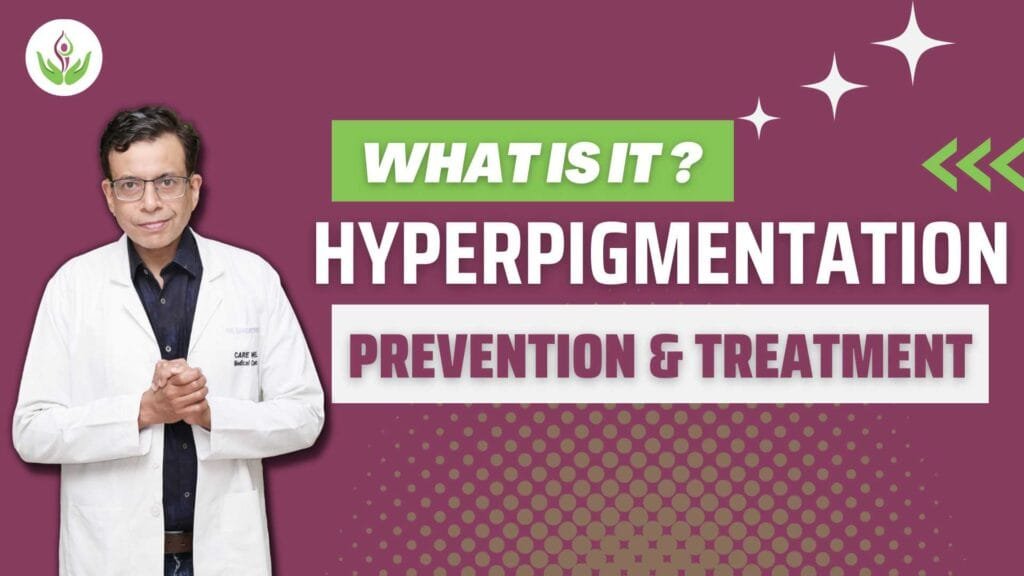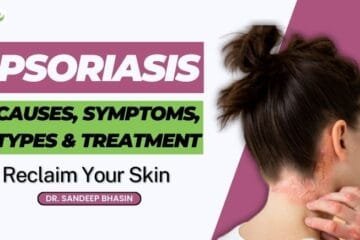Hyperpigmentation is one of the most common skin conditions. Simply put, the meaning of hyperpigmentation is “more colored or concentrated.” It can be seen as spots or patches of skin that are darker in color than the rest. A prevalent type is hyperpigmentation around the mouth. Hyperpigmentation occurs when the skin releases more melanin in one or more areas than the others. Freckles, age spots, or darker skin patches can all be hyperpigmentation signs.
Types And Symptoms
Types of Hyperpigmentation
There are numerous types of hyperpigmentation, such as Hyperpigmentation on the face due to acne, etc. These are all types of skin pigmentation disorders that can be cured with the proper treatment. Hyperpigmentation is seen on the lips. Smoking or poor oral hygiene are the causes of this.
One can experience hyperpigmentation around the eyes as well. This is often confused with dark circles under the eyes. Side effects of medicines or skin care chemicals can also lead to hyperpigmentation. Injuries or inflammation of the skin, UV damage, abnormal skin growth, hormonal changes, pregnancy, or other medical disorders can all lead to hyperpigmentation.
There are five significant types of Hyperpigmentation, namely, the following:
- Age Spots or Solar Lentigines: This hyperpigmentation is typically seen in all areas of your face and body that are exposed to lots of sunlight. This can be your face, your hands, or your arms. The skin in these areas suffered from darker patches of skin, different from sun tanning, due to an extended and dangerous amount of exposure to sunlight and UV radiation.
- Post-inflammatory Hyperpigmentation: This hyperpigmentation is seen on any part of a person’s face and body wherever they’ve had an inflammatory reaction. Predominantly, acne and acne scars or skin conditions like eczema can be a cause of this type of hyperpigmentation. Post-inflammatory hyperpigmentation also occurs in areas of your body where you have had injuries or cuts prior. When the new skin develops, it can release a varying amount of melanin, causing it to look darker or discolored than the rest of the skin.
- Melasma: Melasma is a type of hyperpigmentation that is usually seen in people or women who have been pregnant. Often, large patches of their face, forehead, or stomach suffer from such brown or darker pigmentation. This is often an effect of the hormones a pregnant body produces and can also be caused as a side effect of birth control medication.
- Metabolic Disorders: Metabolic disorders, including hemochromatosis and deficiencies in vitamin B12 and folic acid, are the leading causes of hyperpigmentation. These also produce pigmentation on exposed skin, mucosal surfaces, and genitalia.
- Hormonal Pigmentations: The skinfold, palms, and pressure points may all exhibit diffuse pigmentation due to underlying hormonal disorders such as thyroid illness and Addison’s disease.
Symptoms of Hyperpigmentation
There are specific, distinct symptoms of recognizing hyperpigmentation conditions of the skin. The most common symptoms of hyperpigmentation include:
- patches in various tones of black or brown
- The skin’s irritation or damage causes the coloring to appear.
- Darkening spots of discoloration following sun exposure
- Raised dark spots that are expanding
These are mostly the signs of hyperpigmentation that you should look for. If you experience these things, you should consider seeing a dermatologist for a complete diagnosis and course of care. It is always safer to refrain from self-medication.
Short-summary
There are three significant types of hyperpigmentation: Age Spots, Post Inflammatory Hyperpigmentation, and Melasma. Additionally, there are two types of diffuse hyperpigmentation types caused by Metabolic Disorders and Hormonal Pigmentations. All these types of hyperpigmentation cause the affected areas of the face and body to be darker than the rest of the skin. They can sometimes lead to raised, dark spots as well.
Causes Of Hyperpigmentation
Causes of hyperpigmentation include a bunch of damaged or dysfunctional skin cells called melanin. When they are healthy, they provide an even-toned skin appearance. When they are damaged, they end up clumping together, causing the skin in that area to be darker. The major causes of hyperpigmentation are as follows:
- Genetics can play a massive role in causing this skin condition. If freckles or disclosed patches run in the family, the same can cause hyperpigmentation in children.
- Endocrine causes hyperpigmentation due to a disease called Addison’s disease. Its effect is most evident in areas of sun exposure, such as the face, neck, and hands. It is also evident in areas exposed to friction, such as elbows and knees.
- Hyperpigmentation is caused in areas of the face and skin that have been injured. If the skin of a particular area is pierced and compromised in purity, it can cause dark patches. When the epidermis is inflamed, the melanocytes are prompted to enhance melanin synthesis.
- Pigments are also transferred to nearby keratinocytes as a result of this process. The post-inflammatory pigmentation darkens with prolonged sun exposure.
- Due to the abundant melanin pigment in their skin, those with darker skin tones are more susceptible to hyperpigmentation. When using certain photosensitive medications, exposure to sunlight causes skin pigmentation.
- Damage may occur to the epidermis, the skin’s topmost layer. This enables the pigments to enter the skin’s dermis layer and become stuck. The pigmentation gets more difficult to correct as a result.
The hyperpigmentation on the stomach and foreheads directly results from an increased hormone level in your body. This results in increased melanin synthesis.
Short-summary
The causes of hyperpigmentation are excessive melanin release due to genetics, injury, or cuts on the skin. Additionally, adverse effects of medications, birth control, and prolonged exposure to the sun can cause it.
How Is Hyperpigmentation Diagnosed?
The diagnosis of hyperpigmentation is a standard process and is quickly made at most hospitals and with most dermatologists. Disorders of skin hyperpigmentation are differentially diagnosed and frequently identified, assessed for, and treated in primary care settings.
A doctor can diagnose your disease in a few different ways. The simplest is a physical exam, which can be conducted in person or by video call. The diagnosis involves the following:
- The first step is to determine the patient’s medical history to ascertain if the parents have been diagnosed with hyperpigmentation. They need to understand if the patient is pregnant. The doctor must determine if the patient is on birth control pills or any other medication likely to cause hormonal imbalance.
- After an initial understanding of the patient’s medical history, the doctor needs information about the sun exposure habits of the patient.
- Then, the dermatologist examines the affected areas of the face and body under specialized light.
- The doctor may do a skin biopsy to determine the problem if a physical examination is insufficient.
- Occasionally, a biopsy or small skin sample is taken to help rule out skin cancer. Melanoma and its antecedents can be ruled out with an excellent dermatologic history, a skin examination, and a skin biopsy.
Once the doctor determines the type and source of the hyperpigmentation, treatment can begin.
Short-summary
The diagnosis of hyperpigmentation is a simple and standard process. The initial consultation can be done in person or via video call. After understanding and determining the patient’s medical history, including the study of their genetics, the doctor may undertake an autopsy to understand the specific type of hyperpigmentation and begin the treatment accordingly.
Best Treatment For Hyperpigmentation
Hyperpigmentation is a common skin condition. Over the years, a treatment has been designed for all types of hyperpigmentation. The variation in treatments helps customers in the following two ways:
- There is a treatment suitable for every skin type. This also accounts for treating different degrees of hyperpigmentation.
- There is a treatment for hyperpigmentation curated for the varying budgetary restrictions different individuals operate within. So there is something for everyone.
Read Too: Benefits of HydraFacial Treatment
Given below is a list of eight treatments for hyperpigmentation and brief information relating to each one of them:
Lightening creams:
The simplest treatment for hyperpigmentation is lightening cream. These creams are readily available in medical and beauty stores, both offline and online. There is a range of lightening creams available regarding the effectiveness of treatment and for various prices.
Lightening creams are typically applied to a cleansed face once or twice a day. The directions to use these creams are straightforward and present on the packaging of the cream itself. They usually come in cream or gel and contain vitamin B3 and licorice extract. For flat areas like melasma or age spots, skin-whitening lotions or gels work well. For the majority of skin types, they work well for spots of discoloration.
Dermabrasion:
Dermabrasion has been used to encourage skin tissue repair and turnover. A dermabrasion procedure often buffs away the skin’s surface, removing dead cells using either crystals or a diamond tip.
It is a deep exfoliation procedure that improves the tone and texture of your skin. Additionally, it can treat skin issues like acne scars, fine lines, wrinkles, age spots, and sun damage.
Dermabrasion helps treat hyperpigmentation and clear out dark patches effectively and painlessly.
Microdermabrasion:
Microdermabrasion is a similar procedure to dermabrasion for treating hyperpigmented dark patches or spots. The difference is that microdermabrasion is used primarily for surface-level impurities and debris. After cleansing the surface, the hyperpigmentation is lightened.
Intense Pulse light therapy:
Non-ablative (fractional) laser therapy includes IPL therapy. IPL therapy, also known as a photo facial, promotes dermal collagen development. Usually, several sessions are necessary.
Intense pulse light therapy is best for treating hyperpigmentation that affects flat areas.
Laser Peel:
Laser peeling is a common treatment for the condition of hyperpigmentation. To lessen the dark areas, the method uses focused light beams.
Ablative and non-ablative lasers are both available. While the former is more intense, the latter is not as intrusive to the skin. Ablative lasers, in a way, remove layers of the skin that are infected or damaged. On the other hand, non-ablative procedures focus on the dermal layer of the skin to encourage the formation of collagen and skin tightening benefits.
Although ablative lasers are more powerful, they could have more negative effects. Both eliminate substances from your skin, so new skin cells regenerate tighter and more toned.
Chemical Peels:
When performing a chemical peel, more acids are used to treat the targeted skin area. By eliminating the top layer of your skin, they lessen the appearance of hyperpigmentation (epidermis).
Chemical peels are particularly useful in treating severe hyperpigmentation. More concentrated chemical peels are capable of piercing through the middle layer of the skin. In such a way, they can cleanse that layer and remove any impurities from the middle of the skin.
Consider obtaining a professional-grade peel at your dermatologist’s clinic, even though many chemical peels are sold over the counter. These are more effective and produce benefits more quickly. In-office peels may raise your risk for adverse effects because of their strength.
Chemical peels might not be your most excellent medical option if you frequently spend time in the sun. Before opting for this treatment for hyperpigmentation, you must consult your dermatologist.
Retinoids:
Retinoids, derived from vitamin A, are among the most traditional over-the-counter skin care components. Their small molecular size lets them treat the skin layers beneath your epidermis by penetrating the skin deeply.
Both prescription and over-the-counter retinoids are available. But OTC versions typically have worse quality.
Face acids:
Face acids and skin acids act by removing the top layer of your skin through exfoliation. When you exfoliate your skin, new skin cells replace the old ones. Due to the process, your skin will become more even in tone and smoother overall.
Many facial acids are sold over-the-counter at drugstores and beauty supply stores. Alpha-hydroxy acids, such as glycolic, lactic, citric, malic, or tartaric acid, are common choices.
Short-summary
There are numerous treatments for hyperpigmentation, and these are available very quickly in today’s time. These treatments range from intense laser peels or dermabrasion to simpler treatments of lightening creams and facial acids. Each treatment has its benefits and harms. The way to determine the treatment suitable for a particular person is by consulting a dermatologist.
Hyperpigmentation Laser Treatment Before And After Results
Based on all the treatments mentioned above, hyperpigmentation can be eradicated. The treatments and preventive measures allow the skin to rid itself of all the impurities and debris.
The treatments for hyperpigmentation cleanse the skin, exfoliate the skin, and activate the melanin skin cells. Once the melanin skin cells are healthy and active, the skin tone evens out. These cause the skin to have a smooth texture and remove all the discoloration caused by hyperpigmentation.
Short-summary
The before and after pictures of treating hyperpigmentation show that, in many cases, the dark patches and spots are lightened heavily, if not entirely removed.
How To Prevent Hyperpigmentation?
Hyperpigmentation is naturally occurring and cannot be outdone completely. However, specific instances of hyperpigmentation can be prevented by following the steps:
- Avoid direct sunlight, especially during the prime time of 10 am to 2 pm. If outdoors, you may use an umbrella or sit under a shade to minimize exposure.
- Incorporate vitamin C into your beauty routine. Vitamin C aids in limiting and neutralizing the harm that the sun’s harmful rays cause. It is rich in antioxidants that hydrate, brighten, and even tone the skin.
- Apply SPF daily to protect your skin from harmful UV rays.
- Limit touching your skin. Scratching or picking on uneven skin can result in inflammation. This leads to darker pigmentation, usually in the form of spots and blemishes. Hence, it’s best to avoid touching your skin unnecessarily. Ensure clean hands for activities like applying skincare or makeup.
While preventing hyperpigmentation isn’t always an option, protecting your delicate skin from the sun’s rays helps. Every day, applying a sunscreen that’s “broad spectrum” (blocks UltraViolet A, and UltraViolet B) with an SPF of either 30 or anything higher can prove helpful. However, too much sun exposure has to be avoided. You may wear full clothing or use physical blockers like zinc oxide or titanium dioxide.
Short-summary
The section provides a few everyday actions individuals can adopt to reduce hyperpigmentation. These steps primarily involve protecting the skin from extended exposure to the sun and taking care of the skin by providing it with adequate nourishment.
Cost Of Hyperpigmentation Treatment In India
The cost of hyperpigmentation treatment depends on the place of treatment. There are three primary considerations for determining the cost of hyperpigmentation. These are the patient’s medical history, the degree of their hyperpigmentation, and their total budget.
On a lower budget, there are many do-it-yourself treatments available. The cost of at-home treatments will be anywhere between Rs. 500 to Rs.2999. These are in the form of home remedies or well-priced creams and serums.
With a higher budget, the cost of hyperpigmentation treatments can be determined based on your chosen procedures or medical treatments. The benefit of a professional procedure is twofold. They are more effective in treating the darker patches and have a quicker process. The cost of hyperpigmentation treatment can vary between Rs.3000- 8000. This price is per session of the chosen treatment.
The cost for microdermabrasion in India at a reputed dermatologist is upwards of Rs.6000. The cost of laser treatment for hyperpigmentation is calculated per session. It costs upwards of Rs.5000 per session. The number of sessions depends on the severity of the hyperpigmentation. This varies from person to person. Chemical peels are another effective treatment for treating hyperpigmentation. They cost anywhere between Rs.2500 to Rs.6000 per peel.
Conclusion
Hyperpigmentation is one of the most common skin conditions of today’s time. These dark spots and patches have varying causes, from genetics to side effects of birth control pills or other chemical drugs. The symptoms of hyperpigmentation are easily identifiable. They appear in patches or areas of your face and body, being darker than the rest of the skin. There are many treatments available for hyperpigmentation. These treatments range in effectiveness, cost, and in their effect on the skin. If you are looking for the best doctor or clinic for hyperpigmentation treatment in Delhi then Care Well Medical Centre is a well-known name for this treatment. Consulting with your dermatologist and starting your treatment for clear, healthier, and glowing skin is the best way to deal with hyperpigmentation.
Resources
- Board-certified dermatologist warns consumers about the dangers of skin bleaching to achieve a lighter complexion. (2021). (Link)
- Ciganović, P., et al. (2019). Glycerolic licorice extracts as active cosmeceutical ingredients: Extraction optimization, chemical characterization, and biological activity. (Link)
- Das, S. (2020). Hyperpigmentation. (Link)
- Eichenfield, D. Z., et al. (2016). Amitriptyline-induced cutaneous hyperpigmentation: Case report and review of psychotropic drug-associated mucocutaneous hyperpigmentation. (Link)
- Ghafarzadeh, M., et al. (2017). Clinical efficacy of liposome-encapsulated Aloe vera on melasma treatment during pregnancy. (Link)
- Hollinger, J. C., et al. (2018). Are natural ingredients effective in the management of hyperpigmentation? A systematic review. (Link)
- How to fade dark spots in darker skin tones. (2014). (Link)
- Hyperpigmentation. (n.d.). (Link)














